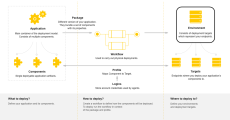Environments
As an Administrator or Operator, you set up and monitor the endpoints (Environments and Deployment Targets) where the Applications and Components will be deployed. You can also provision Environments to reduce manual effort.
An Environment consists of Deployment Targets which represent your endpoints. Different Environments are used for different phases in the software delivery cycle, for example, Development, QA, Staging, Production. An Environment is typically set up once and used by several Applications.
Note: The following graphic illustrates the role of Environments in the Deployment Model. Select the image to expand it.
What are Environments in CDA?
Environments are your endpoints in the CDA Deployment Model. You store your Environments within separate folders for access rights and permission control.
Example: The JBoss Test Environment 1 consists of a Virtual Machine with 4 processors, a Unix operating system, and a JBoss 5.1.0, and should be used primarily for functional tests.
You can define settings or properties (for example, connection strings) which are common to all Deployment Targets within an Environment in the Environment entity, instead of defining them individually per Deployment Target.
Environments can share hardware and infrastructure Components; it is for example, possible that a JBoss Test Environment 2 is targeted to the same virtual machine as the JBoss Test Environment 1 with only a separate installation of the JBoss Server.
See also:
